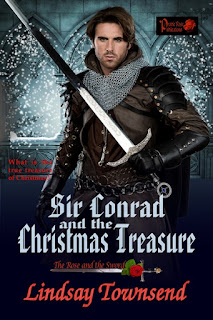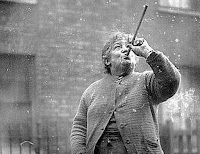In the hushed
stillness of midnight when everyone should be fast asleep, I heard a faint
rustle, like a cat high-stepping through piles of paper. More rustling sounds,
furtive sliding…
“What
are you doing down there!” a male voice thundered.
Someone
shrieked. Strange noises clattered and thumped. Then silence.
I
shot up in bed, flung back the covers and dashed from my room where I had been
recuperating from a cold and sore throat. The living room was dark except for
the glow of colored lights twinkling in the Christmas tree. And there stood my
dad, arms akimbo, trying to look stern as he gazed down at my mother, kneeling amidst
the scattered gifts, much like a deer frozen in beaming headlights.
Of
course my mother couldn’t come up with an explanation. Dad and I both knew curiosity
was the death of any patience on her part when it came to gifts for her. Earlier,
Dad had given me money to buy Mom a present because he knew I would know what
she’d like. I’d snuck it into the house, furtively wrapped it and hid it in my
closet because I knew she could not wait until Christmas Eve. Suspense was
killing her. She just had to find her gift.
That
Christmas, when I was seventeen, was the first time I realized she was very
good at sliding a sharp knife through the tape, carefully unwrapping if a peek
wasn’t enough, then just as carefully rewrapping all the folds and placing new
tape precisely over the old tape. Apparently, she’d been doing it for years. Became
quite accomplished at it. And continued to do so ever after.
Any parcel from my
brother in Toronto was opened ahead of time. Gift exchanges with her friends
were also opened on the spot or the moment her friend went home. I resorted to
urging my brother to send the parcel c/o me, but he didn’t believe me
<grin>. Hence, if it hadn’t been for the gifts we brought, my mother
would have had nothing to open on Christmas Eve. Or on her birthday. Or Mother’s
Day.
I’m just the
opposite. I love the anticipation. Love shaking a gift. Could it be perfume?
And I love having fun with the gifts. I’ll write cryptic message on the gift
tag, to give a clue to the contents. I also save boxes throughout the year
because square shapes are so much easier to wrap. One time one of my boys
opened a box and tossed it aside without opening it. I reassured him that you
can’t always judge a gift by its container. <grin>
My dad wasn’t big
on Christmas decorating, so he often brought home the sorriest-looking tree in
the lot, stuck it in an old steel tire rim and left it to me to create magic.
Of course there was no water for the tree to absorb, so by New Year’s the
needles were probably falling off. But oh, the lead tinsel from those days, how
they made a tree glitter like magic. I miss the tinsel, in fact I saved it from
year to year for a long time until one could only buy that fly-away stuff that
if someone sneezed or opened a door causing a draft, it would fly off the tree.
And speaking of
trees, here’s the first of three tales of Christmas trees. It was my first time
picking out a tree. It had to be perfect, as all new brides anxiously want
everything to be perfect. And the tree I found, was of course the biggest, after
lifting and scrutinizing dozens of trees. It was a bushy, fragrant tree that
almost scraped our apartment ceiling. We set it in the corner of the living
room, had fun decorating, and when we were all done, we closed the folding door
that separated our bedroom from the living room. Moments later, we heard an odd
scraping sound and a whooshing thump. The tree had fainted.
Luckily, there was
little damage, a few broken ornaments and pine needles. In no time everything
was perfect again, we slid the door shut and went to bed. Moments later, again
that odd scraping sound and whooshing thump. Yep, you guessed it. The tree had
fainted a second time. We also figured out why. The sliding door probably
nudged it.
This time Doug got
a nail and hammer and string, tied a long cord around the trunk and nailed that
tree to the wall. The tree never had another fainting spell.
When our second
Christmas arrived, we were in Germany. We were able to go to a tree nursery,
select the tree we wanted and then the attendant chopped it down for us and
strapped it to our car. Back then, it was quite the custom to put a small tree
on top of a table. I missed a full-size tree, so the next Christmas we had
moved into an apartment building and had a tall tree. By the following
Christmas we had switched apartments with another military family who wanted a
second bedroom for their newborn. I was quite happy with the switch because we
now had a second-floor unit with a long balcony. It was fun having a bigger
living room and we went all out decorating with lights around the windows and
balcony.
That evening we
heard a bunch of voices drifting up from outdoors. We looked out the window and
saw pedestrians standing and pointing at our apartment. More people gathered.
Even cars stopped and people rolled down their windows and stared, pointing.
Things may have changed since 1968, but at that time white lights were the only
colors on trees or outdoors. Indoor trees were lit with candles in special
holders and shouldn’t be left unattended. The German people had never seen
colored lights, let alone on a Christmas tree.
The couple living
in the apartment directly beside us had a young girl and boy, probably aged
five and six. I’d hear them giggling in their bedroom which was on the other
side of my kitchen wall. When they saw our tree for the first time they stood in
awe at the wonder of colored lights. When we moved back to Canada, we gave them
all our Christmas lights.

And now onto the
tale of the third Christmas tree. Many, many years later, Doug and the three
youngest boys, all older teens by now, went with their dad to Calgary early Sunday
morning to bring Chris back home to stay. I decorated our beautiful big tree,
and went to bed, unaware that Doug and the boys were stranded at a truck stop an
hour’s drive away. They had left Calgary later than planned, and luckily made
it to Brooks. The highway had been closed due to a fierce blizzard. I went to work the next day as usual, so I
missed the surprise that awaited Doug and the boys when they arrived home
around eight in the morning. Chris was especially tired and went into the
living room and discovered the tree had “fainted” on the carpet. Oh no! No one
needed this mess after the harrowing night they’d spent without any sleep.
Doug and Chris
righted the tree and seconds later it started falling again. Luckily, they
caught it. While Doug held the tree, Chris went and rummaged in his toolbox,
got out the drill and drilled through the tree stand attached to a square of
plywood, and “nailed” that tree to the carpet. “Now, try and fall down, you
s.o.b.” he muttered.
As extra
insurance, a thick string was looped around the trunk and secured to the wall.
To this day, that hook and string is still there to keep the tree from
fainting. <grin>
Do you remember
when you or your children helped decorate the tree as high as they could reach
(and then the perfectionist re-did the tree while the “elves” were sleeping?) Methinks
I was guilty of the same…or was I just too tired to notice the imbalance?
I have a couple
more anecdotes to share, that I hope will make you laugh, or at least smile? My
family always opened gifts on Christmas Eve whereas Doug’s family opened gifts
on Christmas morning. For several years, we opened gifts around midnight until
we came back home from Germany. I always reserved one special gift for Doug for
Christmas morning so he would have a special gift besides what was hung in his
stocking.
One year I
arranged with our neighbor to have a snow blower delivered from Sears and stored
in his garage. Then he was to bring it over Christmas morning so Doug would
have a surprise. I tried everything to get Doug to go outside. Finally he did,
and nearly tripped over the dang thing when he opened the door. Dwayne had really
planted it right by the door.
It never snowed
that winter!
Now for a funny
that still makes me smile as I type this—and it is something we’ve reminisced about
around the dinner table when we were too stuffed with turkey and dressing to
move for a while. In the fall of 1994 Dolly Parton released an autobiography. The
bookstore had a special display of her book, complete with a life-size
cardboard photo of herself. As I paid for my copy, I asked the clerk if I could
have/buy the cut-out when the promotion was over. And shortly before Christmas
the store called. I picked up “Dolly” and had Chris take “her” downstairs where
he hid her in his closet until Christmas morning.
While I had Doug
preoccupied with some task, maybe taking out the garbage—LOL, Chris put Dolly
in the bathroom off our bedroom, and for some unknown reason, left the light on
before closing the door. A while later, Doug went into the bedroom, saw the door
was closed, and being the polite gentleman that he is, knocked on the door.
Receiving no answer, he opened the door saw a woman standing there, muttered “Oh,
excuse me,” and whipped the door shut.
The boys and I were
just outside the bedroom door, holding our breaths and mirth. And then we heard
the Lord’s name in an explosive burst when he re-opened the door. Doug is such
a good sport and laughed right along with us, after he caught his breath. He’s
a Dolly fan, too, hence the idea for my prank.
I hope this little
glimpse in my world has left you smiling. That’s what Christmas is all about,
love, laughter, family and friends and grateful to God and his Son for all our
blessings. May your Christmas be filled with joy and light, and if you’re
alone, re-visit your memories to coax a smile. Merry Christmas and have a
wonderful new year.
Excerpt: Beneath A
Horse-Thief Moon
Ten minutes later Chase couldn't wait any longer. He wanted Sara
beside him. He hurriedly lit the dozens of candles he'd fastened to the fir
boughs. “Sara? You ready to come out now? It's lonely out here without you.”
“I'm coming,” she replied, her voice muffled.
In two strides he was at the bedroom door and watched her struggle
into a nightgown. “Let me help.”
From behind his back he produced a tissue-wrapped parcel tied with
a green ribbon and dropped it into her lap.
“I couldn't wait any longer. Merry Christmas, Sara.”
She gazed at him, her mouth a perfect circle of surprise. “A
present? For me?” she said in a hushed voice. “I've never had a Christmas
present. Not even a doll.”
He ached for what she'd missed. “Next Christmas I'll buy you a
dozen dolls.” He watched her untie the ribbon and fold back the tissue. Emerald
satin shimmered in the candlelight. “Oh, my,” she breathed. A big, fat tear
rolled down her cheek. “Oh, my.”
“Hey, you're not supposed to cry. I'll take it back.” He reached to
take the parcel.
She grabbed it back. “It's the most beautiful gown I've ever seen.
But it's far too fine for the likes of me.”
Chase heaved a sigh of relief. “No, it's you wearing it that makes
it look fine.”
Sara cupped his face and kissed him. “You are the sweetest, most
generous person I know. What did I ever do to deserve you?”
Chase shrugged, trying hard to hide his pleasure. “Let's get this
on you. Hope it fits. I ordered it from Boston.”
He lifted her old nightgown from where it bunched around her
shoulders and grinned at her nudity. “On second thought, I like you just the
way you are.”
“Chase!” Sara ducked her head to hide her face.
With a laugh, Chase bunched up the green gown. “Raise your arms.”
She complied. Her eyes fluttered shut and a moan of pure pleasure
escaped her lips when the material slid over her breasts. He helped her stand
and slid the sleeves of the matching peignoir up her arms. A crush of green
ruffles framed her face and floated in twin panels down her front.
Chase unraveled her braid and let it cascade in waves down her
back and over her breasts. “You're so beautiful, Sara.” He adored her with his
eyes, then lifted her into his arms.
“Chase, you're crushing my gown.”
“I like the feel of you in my arms.” Walking into the main room,
he sat her down in the rocker he'd pulled close to the fire. Around her legs he
wrapped Silver's old blue horse blanket.
“Oh, Chase, the tree is so beautiful. And smells like the forest
is inside. I've never had a Christmas tree before.”
Although she said it without a trace of self-pity, a lump formed
in his throat that this lovely, generous woman had been so deprived of even the
most simple things in life that most people took for granted. “How come?”
www.elizabethclements.com





























